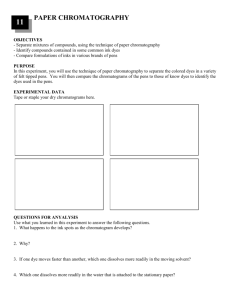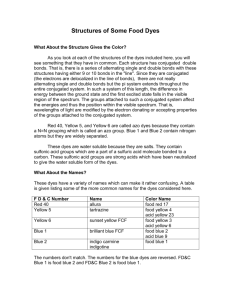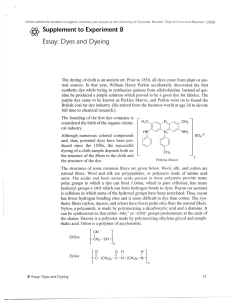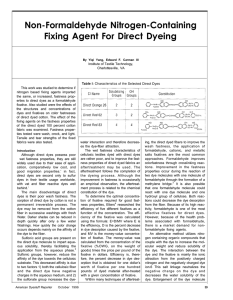Textiles, Tiles and China
advertisement
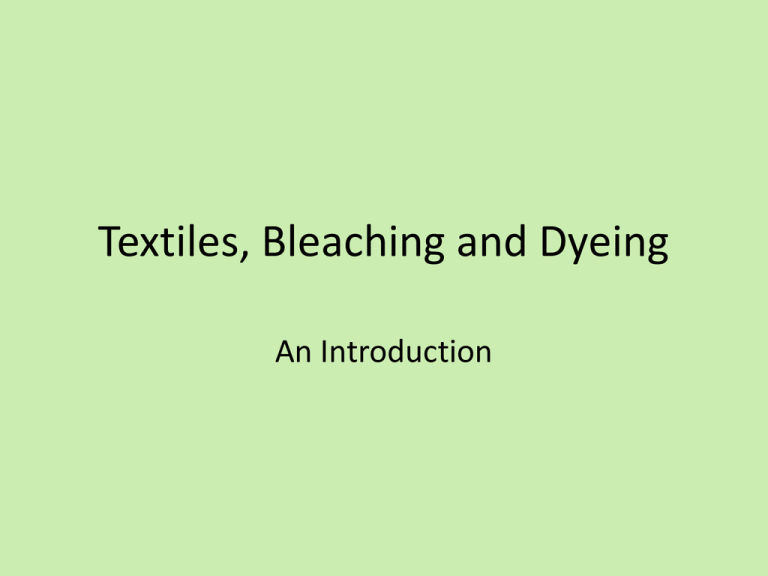
Textiles, Bleaching and Dyeing An Introduction Textiles • Ancient craft using natural resources (wool, cotton, flax) for making fabric for clothing, shelter, bedding, floor covering, ... • Mechanical aspects: picking, cleaning, carding, spinning, weaving and making final product. • During the Industrial Revolution, the textile industry rapidly expanded and advanced technologically. Industrial Revolution • New inventions were assisted by the patent process, availability of investors, preventing knowledge to leave Britain. • Advances in power: manual, water, steam engines. • Growing sources of natural resources and markets (colonies). • Improving transportation infrastructure. Textiles: Bleaching • Bleaching fabric whitens it. • Pre-IR: wash in soap, boil fabric in strong base (lye soda ash; also NaOH), expose to sunlight. • Transition to Palaeotechnic: soak in weak acid (sulphuric and hydrochloric), and then base (lime, alkali). • Palaeotechnic: use of chlorine as bleach (Berthollet and Scheele, France , 1785) How Does Bleach Work? • Bleach oxidizes compounds (stains, dye, germs) by breaking chemical bonds and inserting oxygen or by converting C=C and/or C=O double bonds to single bonds. Chemistry • 1785 H2SO4 + 2NaCl Na2SO4 + 2HCl Vitriol + common salt 2HCl + MnO2 Cl2 + MnO + H2O muriatic acid + black calx of Mn • H2O + Cl2 (aq) 2H+(aq) + Cl-(aq) + OCl(aq) Water + chlorine hydrogen and chloride ions and HYPOCHLORITE ion Textiles: Dyeing • Dyes give color to fabric. • The first dyes were from minerals or extracted from plants and animals. Most of the latter were organic molecules (primarily C and H). • Indigo was one of the earliest organic dyes. Chemical Questions • As advances in textile production and bleaching were made, interest in fabric dyes increased: studying its chemical composition, improving extraction methods, modifying chemical composition to produce different dyes, discovering ways to make the dyes more colorfast , minimizing toxicity...There was a rich chemistry involved in these investigations. From Natural Dyes to Synthetic Dyes • The next logical step was to make dyes from chemicals in the lab or manufactory. • The first dye was synthesized by Perkins (an 18 year old lab assistant in London) in 1856: Tyrian purple, mauve or maureine. • This grew out of the products of the coal tar industry, one of which was aniline. • These dyes are organic compounds. Synthesis of the Dye called Mauve • REACTANTS: C6H7N + K2Cr2O7 + C7H9N + H2SO4 aniline + potassium dichromate + p-toluidine + sulfuric acid • PRODUCTS: a complex mixture of at least four methyl derivatives (C24 to C28) with a 7-amino-5phenyl-3-(phenylamino)phenazin-5-ium core. http://www3.interscience.wiley.com/journal/121 359283/abstract?CRETRY=1&SRETRY=0 • Products first verified in 1994 with more work in 2007 Mauveine Chemical Structures Aniline and Toluidine One Structure of Mauveine Chromophores • The C =C bonds in the dye absorb light in the ultra-violet (λ < 200 nm) and visible (λ = 200700 nm) region of the light spectrum causing the dye molecule to go from a ground state to an excited state. When the molecule returns to the ground state, visible light (λ = 450 nm; purple; ) is emitted and observed. • These molecules are called chromophores (chrom = color). Visible Light Spectrum • http://images.google.co.uk/images?q=visible+ spectrum&ie=UTF-8&oe=utf8&rls=org.mozilla:enUS:official&client=firefoxa&um=1&sa=X&oi=image_result_group&resn um=4&ct=title • 400 nm = violet; 500 nm = green; 575 nm = yellow; 700 nm = red Dyes – Fabric Bond • Dyes must adhere to the fabric. There are two mechanisms – The formation of chemical bonds between the fabric and dye. – The use of a third compound (called a mordant like alum) to form an insoluble compound with the dye. This product then adheres to the fabric. References • http://potency.berkeley.edu/chempages/ANILI NE.html • http://www.chemsynthesis.com/base/chemic al-structure-3482.html • http://www.rsc.org/Publishing/ChemScience/ Volume/2007/06/mysteries_mauve.asp



